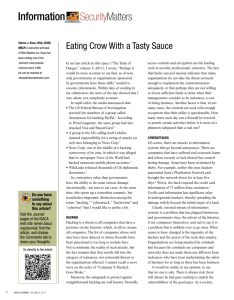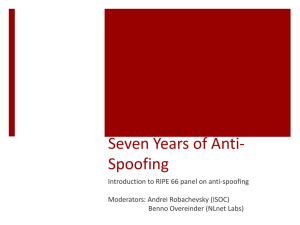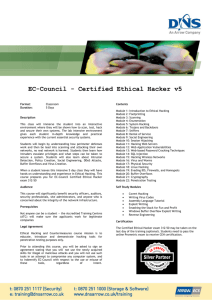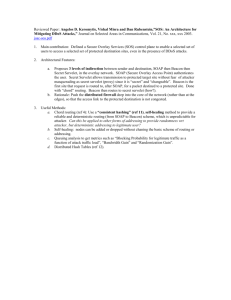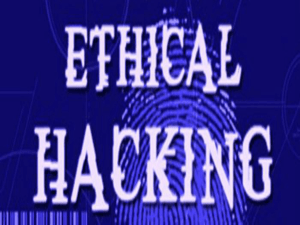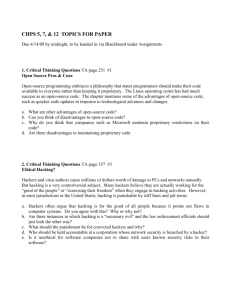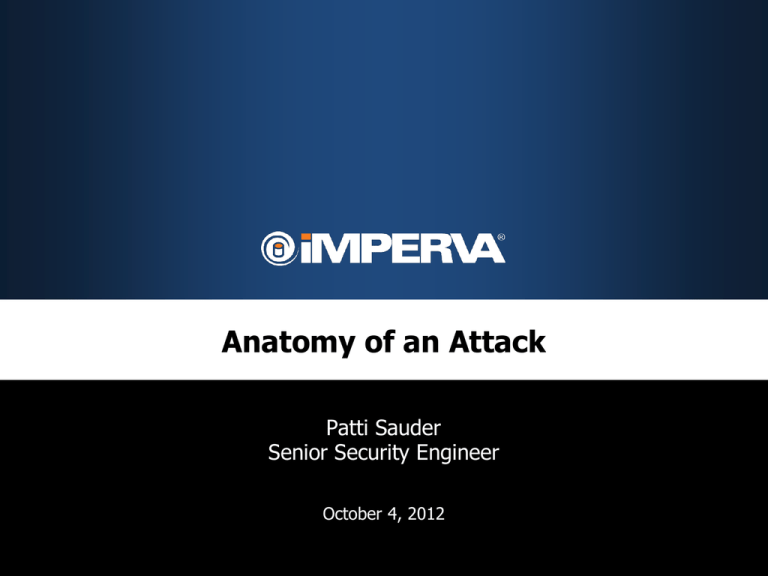
Anatomy of an Attack
Patti Sauder
Senior Security Engineer
October 4, 2012
2
- CONFIDENTIAL -
Imperva Overview
Our mission.
Protect the data that drives business
Our market segment.
Enterprise Data Security
Our global business.
• Founded in 2002;
•
•
•
Global operations; HQ in Redwood Shores, CA
375+ employees
Customers in 50+ countries
Our customers.
1,700+ direct; Thousands cloud-based
•
•
•
•
•
3
4 of the top 5 global financial data service firms
4 of the top 5 global telecommunications firms
4 of the top 5 global computer hardware companies
3 of the top 5 US commercial banks
150+ government agencies and departments
Next Generation Threats Require New Approach
Tech. Attack
Protection
Usage
Audit
Logic Attack
Protection
User Rights
Management
Fraud
Prevention
Access
Control
External
Internal
Customers
Staff, Partners
Hackers
Employees
Malicious Insiders
Compromised Insiders
Data Center
Systems and Admins
Imperva’s Mission is to Provide a Complete Solution
4
© Copyright 2012 Imperva, Inc. All rights reserved.
“Never been easier”
…to become a cybercriminal.
Hacking
- Foreign Secretary William Hague
Foreign Secretary William Hague reported
to an international conference that it has
“never been easier” to become a
cybercriminal.
-- BBC News October 4, 2012
5
Motivation
Hacking
• Hacking for reputation, military or financial
gain. Typically underground or secretive teams
and organizations using significant effort to hide
their nefarious activities.
• Often an income source for organized crime.
• Significant steps to hid their activities
Social
Hacktivism
• Combination
of hacking and activism, often
powered by the use of social media
• Usually political or ethical opinion drivers.
•Proven to be quite effective
• Verizon Data Breach report states that 58% of
stolen records in 2011 were due to hacktivism.
With zero losses were attributed to hacktivism in
previous years.
6
Types of Threats
Malicious
Insiders
According to the Verizon 2011 Data Breach Investigations Report,
the number of incidents implicating malicious insiders
doubled in 2011. Example: Wikileaks and Zappos
Compromised
Insiders
According to the Office of the Director of National Intelligence,
almost half of all computers in the United States have been
compromised in some manner and ~60,000 new pieces of
malware are identified per day.
Automated
Attacks
7
“External agents have created economies of scale by refining
standardized, automated, and highly repeatable attacks
directed at smaller, vulnerable, and largely homogenous targets.”
– Verizon 2011 Data Breach Investigations Report
Industrialization of Hacking and Automation
Roles
Optimization
Researching Vulnerabilities
Direct Value – i.e. IP, CC#
Developing Exploits
Command & Control
Growing Botnets
Malware Distribution
Exploiting Targets
Phishing & spam
Creating Tools
DDoS
Consumers
Use & Rent Resources
Great at using
information/tools already in
place
8
Automation
Growing Botnets and
Exploiting Vulnerabilities
Selecting Targets via Search
Engines
Templates & Kits
Centralized Management
Service & Support
Department
Situation Today
# of websites
(estimated: July 2011)
: 357,292,065
x
230
But which will be
1%
exploited?
# of
vulnerabilities :
821,771,600
vulnerabilities in active circulation
http://news.netcraft.com/archives/2011/07/08/july-2011-web-server-survey.html
https://www.whitehatsec.com/home/resource/stats.html
Data is hacker currency
Canadian credit cards:
Visa: $3
MasterCard: $3
American Express: $6
Discover: $6
US credit cards:
Visa: $2
MasterCard: $3
American Express: $5
Discover: $6
EU credit cards:
Visa: $6
MasterCard: $6
American Express: $8
Discover: $8
Website Access up for Sale
11
- CONFIDENTIAL -
Website Access up for Sale
12
- CONFIDENTIAL -
Automation Makes It Easy
In one hacker forum, it was boasted that one hacker had found
5012 websites vulnerable to SQLi through automation tools.
Note:
•Due to automation, hackers can
be effective in small groups – i.e.
Lulzsec.
• Automation also means that
attacks are equal opportunity
offenders. They don’t
discriminate between well-known
and unknown sites.
The Story
Understanding the Threat Landscape - Sources
Hacking data source
+ Categorized attacks across 40 web applications
+ Reviewed all HTTP & HTTPS traffic
+ 6 months: June to November 2011
Social hacktivism data source
+ Imperva mitigated attack in 2011
+ Activity lasted 25 days
+ Defensive line was network firewall, IDS, WAF, web servers and
anti-virus.
Types of Attackers
Both Hacking
and Social
Hacktivism
Skilled hackers—This group have genuine hacking experience
and are quite savvy with web application exploitation.
Nontechnical—This group can be quite large, ranging from a
Social
few dozen to a few hundred volunteers. Directed by the skilled
Hacktivism Only hackers, their role is primarily to conduct DDoS attacks by either
downloading and using special software or visiting websites
designed to flood victims with excessive traffic.
16
Attack Breakdown – Standard Hacking
PHP in use in +77% of web apps.
* RFI, LFI and DT do not appear in OWASP’s Web Attack top 10 list.
Attack Breakdown– Social Hacktivism
4000
3500
DT
3000
#alerts
2500
Directory Traversal
SQLi
2000
SQL injection
DDoS recon
1500
XSS
1000
XSS
500
0
Day 19
Day 20
Day 21
Date
18
Day 22
Day 23
19
- CONFIDENTIAL -
The Plot
Attack took place in 2011
over a 25 day period.
Anonymous was on a
deadline to breach and
disrupt a website, a
proactive attempt at
hacktivism.
10-15 skilled hackers or
“geniuses.”
Several hundred to a
thousand “idiots.”
20
Recruiting and Communications
21
An “Inspirational” Video
22
Social Media Helps Recruit
23
Setting Up An Early Warning System
24
Example
25
But That Much Sophistication Isn’t Always Required
26
Hacker Tools
“Avoid strength, attack weakness: Striking where the enemy is
most vulnerable.”
—Sun Tzu
27
Automation is Prevailing
Tools and kits exist for everything
Finding Vulnerabilities
Tool #1: Vulnerability Scanners
Purpose: Rapidly find application vulnerabilities.
Cost: $0-$1000 per license.
The specific tools:
+ Acunetix (named a “Visionary” in a Gartner 2011 MQ)
+ Nikto (open source)
29
Industrial vs. Social DDOS
Traditional Application DDOS – Traditional application DDOS
requires a significant effort on the part of the hacker, buying or
building C&C tools, discovering exploits on target systems and
expanding a large enough botnet to execute the DDOS. The
advantage is that the hacker can attack targets at will without the
need to publicly ‘ask’ others for help or meet a specific timeline. But
it requires significant effort upfront.
Social DDOS – Supporter run DDOS requires far less effort on the
behalf of the attacker, but requires enough supporters ‘willing’ to
assist in the attack before it can be executed. The only effort is in
creating easy to use DDOS tools and providing them to the
‘supporters’.
For more: http://blog.imperva.com/2011/12/top-cyber-security-trends-for-2012-7.html
30
Hacking Tools
Tool #2: Low-Orbit Ion Canon (LOIC)
Purpose:
+ DDoS
+ Mobile and Javascript variations
+ Can create 200 requests per second per browser window
32
LOIC Facts
LOIC downloads
+ 2011: 381,976
+ 2012 (through March 19): 318,340
+ Jan 2012=83% of 2011’s downloads!
Javascript LOIC:
+ Easy to create
+ Iterates up to 200 requests per minute
+ Can be used via mobile device.
33
Data Extraction
Tool #3: Havij
Purpose:
+ Automated SQL injection
and data harvesting
tool.
+ Solely developed to take
data transacted by
applications
Developed in Iran
34
Mitigation Techniques
Dork Yourself
Blacklist
WAF + VA
WAF Anti-DDOS
IP Reputation
Code Fixing
Protect Your Organization’s Data
Given all the billions spent
on security,
why the prolific rate of
data breaches?
36
Recent attacker targets….
US Department of Justice
Church of Scientology
US Copyright Office
Muslim Brotherhood
FBI
Zappos.com
MPAA
MilitarySingles.com
Warner Brothers
Amazon
RIAA
Austria Federal Chancellor
HADOPI
HBGary Federal
BMI
Mexican Interior Ministry
SOHH
Mexican Senate
Office of the AU Prime Minister
Mexican Chamber of Deputies
How
many
of
these
organizations
AU House of Parliament
Irish
Department
of Justice have AV, IPS and
AU Department of Communications
Irish Department
of Finance
Next
Generations
Firewalls?
Swiss bank PostFinance
Greek Department of Justice
Fine Gael
Egyptian National Democratic Party
New Zealand
Parliament
Spanish
Police
Why
are the attacks
successful
when these technologies claim
Tunisia Government
Orlando Chamber of Commerce
to prevent them?
Zimbabwe Government
Catholic Diocese of Orlando
Egyptian Government
Bay Area Rapid Transit
Itau
PayPal
Banco de Brazil
Mastercard
US Senate
Visa
Caixa
37
Traditional Security Doesn’t Stop Today’s Threats
What
helped get
us
secure…
isn’t
keeping us
secure
•
•
•
•
•
Router ACLs
Network Firewalls
IDS and IPS
VPNs
Anti-Virus
•
•
•
•
•
•
SQL Injection
(XSS) Cross-site Scripting
Remote File Inclusion
Cross-site Request Forgery
Business Logic Attacks
Insider Abuse
I have IPS and NGFW, am I safe?
IPS and NGFWs can’t prevent all web application attacks.
+ Don’t confuse “application aware marketing” with Web Application
Security.
To prevent, WAFs at a minimum must include the
following to protect web applications:
•
•
•
•
•
•
•
39
Web-App Profile
Web-App Signatures
Web-App Protocol Security
Web-App DDOS Security
Web-App Cookie Protection
Anonymous Proxy/TOR IP Security
HTTPS (SSL) visibility
Security Policy Correlation
I have IPS and NGFW, am I safe?
IPS and NGFWs are not web application firewalls.
+ Don’t confuse “application aware marketing” with Web Application
Security.
However, IPS and NGFWs at best only partially support
the items in Red:
•
•
•
•
•
•
•
40
Web-App Profile
Web-App Signatures
Web-App Protocol Security
Web-App DDOS Security
Web-App Cookie Protection
Anonymous Proxy/TOR IP Security
HTTPS (SSL) visibility
Security Policy Correlation
The Defenses Required to Protect Web Apps
Correlated Attack Validation
Dynamic Profiling
Attack Signatures
HTTP Protocol Validation
Cookie Protection
IP Reputation
Anti-Scraping Policies
Bot Mitigation Policies
IP Geolocation
Malware Fraud Detection
41
Technical Attack
Protection
© Copyright 2012 Imperva, Inc. All rights reserved.
Business Logic
Attack Protection
Fraud Prevention
42
- CONFIDENTIAL -
References
• http://news.netcraft.com/archives/2011/07/08/july-2011-web-server-survey.html
• https://www.whitehatsec.com/home/resource/stats.html
• http://www.verizonbusiness.com/resources/reports/rp_data-breach-investigationsreport-2011_en_xg.pdf
• http://blog.imperva.com/2011/06/analyzing-the-lulzsec-attacks-.html
• http://www.imperva.com/docs/HI_Search_Engine_Poisoning_SEP.pdf
• http://www.imperva.com/docs/HII_The_Anatomy_of_an_Anonymous_Attack.pdf
•http://www.imperva.com/docs/HII_Remote_and_Local_File_Inclusion_Vulnerabiliti
es.pdf



